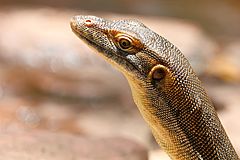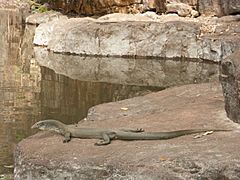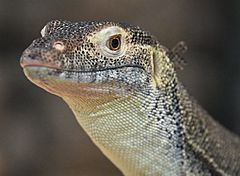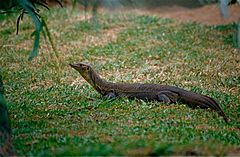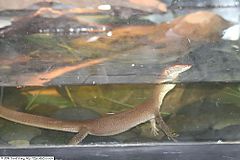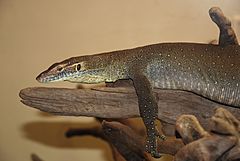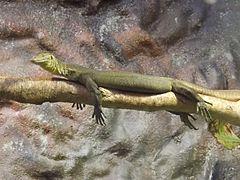Mertens' water monitor facts for kids
Quick facts for kids Mertens' water monitor |
|
|---|---|
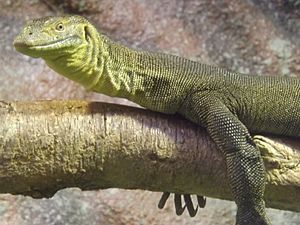 |
|
| Mertens' water monitor at Healesville Sanctuary | |
| Conservation status | |
| Scientific classification | |
| Genus: |
Varanus
|
| Species: |
mertensi
|
The Mertens' water monitor (Varanus mertensi) is a type of lizard. It belongs to the Varanidae family, which includes all monitor lizards. People sometimes call it Mertens's water monitor.
This lizard lives only in northern Australia. It is a skilled hunter that actively searches for food. It mostly lives near water, like rivers and swamps. The lizard is named after a German scientist, Robert Mertens.
Contents
Description
The Mertens' water monitor can grow to be about 1.0 meter (3.3 feet) long. This measurement includes its body and its long tail.
Its back is dark brown or black. It has many cream or yellow spots. Its belly is lighter, usually white or yellowish. The lizard has grey patterns on its throat. Its chest has blue-grey stripes.
The tail is flat on the sides. It has a raised ridge along the top. The tail is about 1.5 times longer than its head and body combined. This strong tail helps it swim.
Distribution and Habitat
Mertens' water monitors live in many parts of northern Australia. You can find them in coastal areas and inland waters.
They live in the Kimberley region of Western Australia. They also live across the Top End of the Northern Territory. Their home range extends to the Gulf Country and the western side of the Cape York Peninsula in Far North Queensland.
Behaviour
The Mertens' water monitor loves water. It is a semiaquatic animal, meaning it lives partly on land and partly in water. It is a very strong swimmer.
These lizards are rarely far from water. You can often see them warming up in the sun. They bask on rocks or logs in the middle of streams. They also rest on branches hanging over swamps, lagoons, and rivers. If something scares them, they quickly drop into the water. They can stay underwater for a long time.
Feeding
Mertens' water monitors find food both on land and in the water. Their main diet includes fish, frogs, and dead animals (carrion).
They also eat land animals and insects when they can find them. These lizards have a great sense of smell. They might dig for food, including the eggs of freshwater turtles.
Reproduction
Mertens' water monitors lay their eggs in a burrow. They usually lay eggs early in the dry season. The baby lizards hatch during the following wet season.
The eggs take about 200 to 300 days to hatch. The exact time depends on the temperature. Once they hatch, the baby monitors can go into the water and swim right away.
Conservation and Status
The Mertens' water monitor faces a big threat. This threat is the spread of cane toads across its home range.
Cane toads are poisonous. When the monitor lizards eat them, they get poisoned. Because of this danger, the Mertens' water monitor is listed as a Vulnerable species. This listing is under the laws of the Northern Territory.
Gallery
-
Mertens' water monitor at the Grotto waterhole near Wyndham, Western Australia
See also
 In Spanish: Varanus mertensi para niños
In Spanish: Varanus mertensi para niños



